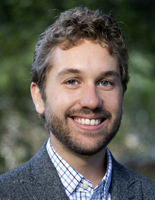 New faculty member Sam Coogan approaches metropolitan transportation puzzles with fundamental mathematical models.
New faculty member Sam Coogan approaches metropolitan transportation puzzles with fundamental mathematical models.
UCLA’s Electrical Engineering Department welcomed 2014 Leon O. Chua Award winner Sam Coogan to its faculty as an assistant professor last year.
Specializing in Control Theory, Coogan tackles metropolitan transportation puzzles with fundamental mathematical models. Coogan’s passion for Control Theory can date back to his undergraduate years at Georgia Tech.
“When I was an undergrad, I took my first Control Theory course in my junior year. The professor opened the class by saying, ‘I’m going to teach you the kinds of skills you will need to be a rocket scientist’ ,” Coogan recalled. “That really sparked my interest. From there, I knew that’s what I wanted to do.”
And sure enough, in 2012, Coogan did shortly become a rocket scientist at NASA’s Jet Propulsion Lab located in Pasadena. As a research intern, he worked on a project called Small Body Navigation where he helped develop algorithms for controlling spacecrafts to small astronomical bodies like spinning asteroids and comets.
After living the excitement in the idealistic bubble of NASA, Coogan returned to his own research at UC Berkeley where he received both his M.S. and Ph.D. degrees in Electrical Engineering under the supervision of Professor Murat Arcak. Coogan said he was looking for interesting real world examples to apply his theoretical results to, when some faculty suggested traffic networks. At first, the glamour-less traffic network did not sound as exciting as asteroids to Coogan. However, as he delved into the field, he actually discovered the mathematical puzzles in traffic systems to be very interesting.
“Today, you have two serious problems. In large cities like LA, you have just way too many people. And you can’t build new infrastructures anymore,” Coogan said. “If I can’t build more roads, how can I use the roads I have, better?”
“Another major issue is found in cities that are developing rapidly. Car ownership is going through the roof in many parts of the world, where there were far fewer cars just 10 or 15 years ago,” Coogan said. “It’s a similar but differently motivated problem. So, how can we move people around efficiently, smartly, and with fewer emissions?”
To address these challenging problems, Coogan set out to develop fundamental mathematical models to simulate traffic flows in roads. His models feature aggregate vehicles moving around at a citywide scale over time. Coogan said they can improve our understanding of where to expect congestion to form and to dissipate; how congestion profiles might change over the rush hours of the day.
Coogan is currently working with Sensys Networks, Inc., where in-ground sensors are developed to capture traffic movements by registering every single car that passes above the sensor. The data can then be used to control traffic intersections, which will be implemented soon, according to Coogan.
Apart from controlling intersections, Coogan said autonomous vehicles will play an important role in the future. They will not only make driving easier, but also alter the nature of traffic flow. Once we have autonomous vehicles, do we even need traffic lights anymore?
Now coming to UCLA to continue his research, Coogan said he will begin teaching in spring quarter. He will teach a junior level course on control theory — EE141: Principles of Feedback Control.
“When I was in college, the classes I remember most are the classes where the faculty were excited to lecture on materials they were passionate about,” Coogan said. “I think it’s important to convey this enthusiasm and spark interests in a new generation.”
